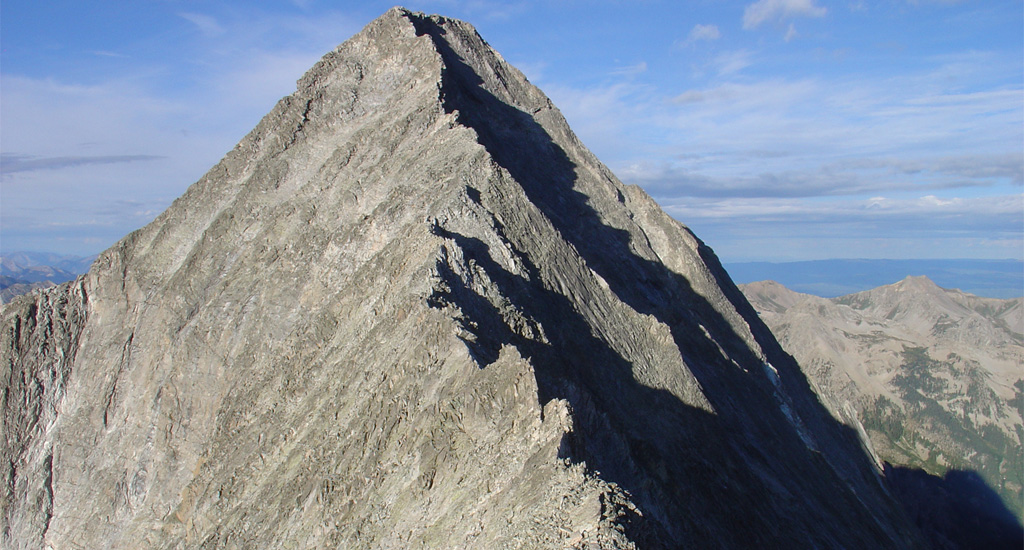1 shows the incredible view of Capitol Peak from the trailhead, where two trails begin: Capitol Creek Trail #1961 and Upper Capitol Creek Trail #1963 (commonly known as the "Ditch" Trail). The Capitol Creek Trail has traditionally been the main approach, but more hikers now prefer the ditch trail since it avoids losing and regaining elevation. This description follows the ditch trail, making the hike to Capitol Lake approximately 6 miles long. From the west end of the trailhead parking area, follow the signed ditch trail (
2). After 1.2 miles, you'll reach a junction at 9,500' (
3) where you'll leave the ditch and continue on a well-defined trail. Weave through the forest, cross a stream, and enter the Maroon Bells-Snowmass Wilderness after passing through a meadow. Continue through aspens and clearings to reach a wide-open area above Capitol Creek (
4). Stay along the hillside for 1.5 miles, then descend to the creek, approximately 3.25 miles from the trailhead (
5). Angle left, cross the creek
, and intersect the main Capitol Creek Trail. Turn right and continue south through meadows (
6). Cross several small streams—including Capitol Creek near 11,000' and 11,100'—as you approach the Capitol Lake area (
7). Near 11,400', turn sharply right to reach a basin just below Capitol Lake, where the designated camp
sites are located (
8).
Just below Capitol Lake, turn left on the Capitol Trail, heading southeast toward the saddle between Mt. Daly and Capitol Peak (
9). Climb 900 feet to reach the saddle
(
10), marking the end of the easy trail portion. From here, you have two options: take the "direct" Class 4 ridge climb south, or follow the standard, easier route on the east side (
11). The standard route is strongly recommended for most hikers. Begin by traversing south from the east side of the saddle; take your time, ensuring you don't lose much elevation as you cross small gullies (
12). The initial traverse may seem confusing, but avoid climbing the cliffs on your right. After traversing 1/4 mile, the route becomes more defined, leading across talus (
13,
14). Near 12,700', angle up to your right (
15) toward 13er "K2," to the southwest (
16). Talus-hop up the slope to K2's right side (
17). Next, you need to get around K2
to continue along the ridge to Capitol. You can either climb over or bypass K2. Climbing K2 is recommended, as it offers stunning views of the remaining route (
18) and includes a short Class 3/4 downclimb to return to the ridge. Alternatively, bypassing K2 involves technically easier moves but on unstable, hazardous terrain. Choose carefully before continuing (
19,
20,
21). After K2, descend into a notch (
22) and climb to a rock tower on the ridge (
23).
The remaining route involves a lot of exposed climbing and will test your route-finding skills. Pause here to assess conditions and make a decision to proceed based on weather. Although the summit isn't far off, the route is time-consuming and a dangerous place to be in bad weather. From the first tower, scramble along the ridge (
24) to reach the Knife Edge, the crux of the route (
25). This short, exposed section demands concentration and a steady nerve. Scramble along the crest (
26) or carefully navigate the left side, holding the ridge (
27). Beyond the Knife Edge, the climbing becomes even more technically challenging. Traverse the ridge or its edges (
28,
29) for about 0.1 mile, then descend to a notch with a steep gully to your left (
30). From here, be sure to study the upper east face, identifying landmarks (
31). Cross the notch and climb a steep pitch, following cairns where possible. Now above 13,800', avoid the remaining ridge crest and traverse the upper east face instead (
32). Angle left to a slate-colored rock wall (
33), cross it (
34), then climb steeply to a notch on the southeast ridge (
35). Turn right to tackle the final, more stable pitch leading to the summit (
36,
37). Congratulations! Take in the incredible summit views (
38,
39) before descending via the same route back to K2 (
40). Do not attempt shortcuts to Capitol Lake, as all terrain along the sides of the ridge leads to dangerous cliffs.
